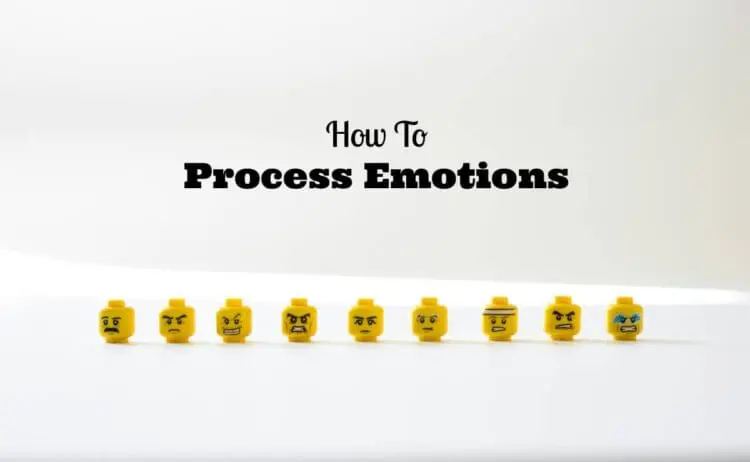When you are learning about emotional states, they seem clear cut- happy or sad. However, as we progress through life, we realize that human emotions can be quite complex. Some of us can can travel along fairly unaware of our emotions until something major happens and we suddenly find ourselves overcome by emotion. At these points in time, some emotional processing may be needed to help us get past what has occurred. In the name of logic, I used to deny many of my feelings. However, I have come to learn that emotions are actually super important to allow ourselves to feel. In fact, allowing ourselves to do the hard work of processing emotions is part of what helps us grow, learn, and heal. That is why I am so happy to have Michael Vallejo, LCSW, a Child and Family Therapist, share with us today about how to process emotions.
Emotional experiences influence our thoughts, behaviors, and relationships with other people. Emotions guide our decision-making processes, inspire us to pursue our goals, allow us to think more creatively, and help us be more self-aware. Because our emotions influence many aspects of our lives, we need to learn how to process them properly. Doing so will allow us to make more balanced decisions.

Understanding Emotional Processing
Processing your emotions involves recognizing them, understanding why they have arisen, and expressing and regulating them in a healthy manner. However, many people can get stuck in this process due to various factors such as:
- Lack of emotional awareness
- Past traumatic experiences
- Fear of vulnerability
- Lack of support
- Lack of healthy coping skills.
Despite these challenges, effectively processing your emotions can have numerous benefits. It helps you regulate your emotional responses, which prevents feelings of being overwhelmed. This, in turn, reduces impulsive behaviors often driven by strong emotions. Moreover, emotional regulations leads to more effective communication and allows you to feel empathy for others.
Lastly, processing your emotions involves introspection, which is important for self-awareness. By understanding your triggers, patterns, and responses, you can know yourself and how to cope with your emotions.
Recognizing and Identifying Emotions
If you want to learn how to process your emotions, the first step is to get in the habit of recognizing and identifying them.
Becoming Emotionally Aware
Without awareness, you will have a difficult time identifying, understanding, or managing your emotions effectively. Having emotional awareness means you can recognize and label your emotions accurately. It also allows you to identify what triggers them.
Emotional awareness allows for timely intervention and regulation before emotions escalate to unmanageable levels.
To develop your emotional awareness, learn to name your emotions. Emotions are complex and there are plenty of words that you can use to describe what you feel.
For example, instead of saying that you’re feeling down because you failed at a task, there might be more specific words that you can use, such as “disappointed,” “embarrassed,” or “frustrated.” An emotional wheel can help you develop an emotional vocabulary.
Next, take regular breaks throughout your day to reflect on your emotions. Take a moment to ask yourself how you are feeling and the reason behind it. It’s also a good idea to reflect on past experiences and how you responded.
Other than that, set aside time to write about your daily experiences and how they made you feel. Note what you were doing or thinking when your emotions occurred so that you can identify patterns and triggers.
Emotional Triggers and Responses
Emotional triggers refer to stimuli that provoke emotional reactions. These could be events, memories, experiences, or thoughts. Understanding your triggers and responses can help you effectively process your emotions.
To help you identify your triggers, you can keep a journal to track situations that trigger strong emotional responses. This will help you plan for situations you know will be triggering so you can develop strategies to cope or set boundaries to protect yourself.

Top Techniques for Processing Emotions
If you’re stuck in strong negative emotions, here are techniques that can help you process them:
1. Mindfulness practice
Mindfulness involves bringing your awareness to the present moment without judgment. This might mean that you observe your thoughts and feelings without labeling them as good or bad.
Instead, you accept your experiences as they are and understand that it’s natural to experience a wide range of emotions.
When you feel a strong emotion, take a moment to pause and breathe deeply to calm your mind and body. Acknowledge the presence of your emotion and try to label it.
Stay present and notice how the emotion makes you feel. Accept the emotion without judgment, and permit yourself to fully experience it. Then, reflect on what might have triggered the emotion. Respond mindfully by engaging in healthy coping activities.
2. Cognitive Restructuring
Cognitive restructuring is a technique wherein you recognize cognitive distortions or irrational ways of thinking and replace them with healthier thoughts. It is important to recognize cognitive distortions because they can negatively influence your emotions and behaviors.
For example, all-or-nothing thinking involves viewing situations in black-and-white terms, so you might think “If I’m not perfect, then I’m a total failure.” In cognitive restructuring, you question the evidence for and against these thoughts.
You challenge your thoughts and determine if it is realistic or helpful. In this case, it’s unrealistic because no one is perfect all the time, and expecting perfection sets an unattainable standard.
Then, you replace it with a balanced thought such as, “Nobody is perfect all the time. I can strive to do my best and learn from my mistakes without calling myself a total failure.”
3. Grounding Technique
Grounding techniques are strategies to help you stay present in the moment and reconnect with the world around you. This can help you prevent being overwhelmed by intense emotions.
Start by recognizing the emotion and labeling it. Pause and breathe to create a moment of calm. Then use a grounding technique such as the “5-4-3-2-1 technique.”
Here’s how the 5-4-3-2-1 technique works:
- Sight: Identify five things you can see.
- Touch: Identify four things you can touch and describe their texture.
- Sound: Identify three things you can hear.
- Smell: Identify two things you can smell.
- Taste: Identify one thing you can taste.
This technique helps you reconnect with the present moment. This pulls your attention away from your overwhelming thoughts or emotional pain.
Once you feel grounded, you can reflect on your emotions and ask yourself what triggered them. You can reframe your thoughts and decide to move forward by talking to someone, journaling your thoughts, or choosing a calming activity to do.
Healthy Coping Mechanisms
Mental health coping skills are important when processing emotions because they provide constructive ways to express your emotions and prevent emotional suppression. These coping mechanisms also help you manage your stress and support your mental health.
Coping skills can be problem-focused, which involves solving a problem so you can remove your source of stress. Or it could be emotion-focused, meaning you change your response to your situation.
Meaning-focused coping involves looking for the positive things in your situation, which applies to situations that you have no control over.
Lastly, support-seeking coping is looking for support from trusted persons so you can reduce negative feelings and be guided to more constructive behaviors.
Here are examples:
- Problem-focused: If you’re stressed about finances, you can create a detailed budget to track your income and expenses.
- Emotion-focused: When you’re feeling anxious, you can practice deep breathing exercises.
- Meaning-focused: Reflect on a challenging experience and how it has helped you grow.
- Support-seeking: This could mean meeting with a trusted friend to talk about what you’re going through or scheduling sessions with a therapist to explore your emotions.
Managing Difficult Emotions
Anxiety, sadness, anger, fear, jealousy, and loneliness are only some of the difficult emotions we experience. These emotions can be challenging to manage, but using coping strategies and seeking support can help reduce the impact of these emotions.
To manage difficult emotions, you must accept them and avoid burying them. Stay present and fully experience the emotions without getting caught up in them.
Challenge negative thoughts, and express your emotions through creative outlets, physical activity, or talking to a trusted person. Then try to use the different coping skills you have learned.

Long-Term Strategies for Emotional Wellness
The key to having long-term emotional wellness is to build habits that support your mental and emotional health. Learning how to deal with your feelings will allow you grow and heal. This includes developing emotional intelligence, which includes increased awareness of your emotions and learning techniques on how to express and regulate your emotions.
Other than that, it is also important to build a support network made up of positive relationships. Cultivate positive thinking through gratitude practice, so you can appreciate the positive aspects of your life.
If you’re struggling, don’t hesitate to seek the help of a mental health professional for guidance and support.
Remember that emotions are a natural part of being human
Bottling up emotions may lead to emotional outbursts or prolonged periods of distress. It’s completely okay to feel whatever you are feeling, and accepting your emotions allows you to pave the way for healing. It is natural for negative experiences to produce unwelcome feelings. Often our core emotions are there to let us know we need to react something. For example, we may need to learn how to turn our emotional hurt into boundaries that protect us. We may need to learn how to our anger into expressing ourselves in healthy ways.
Remember that if you can’t seem to make progress, you can seek professional help. Cognitive Behavioral Therapy (CBT) is a type of psychotherapy that helps people understand the thoughts and feelings that influence behaviors. CBT is commonly used to treat a wide range of issues, including anxiety, depression, and other emotional problems.
Progress might feel slow, but every small step you take toward understanding and processing your emotions is meaningful. Celebrate these small victories.
Related Posts:

Raven says
This blog is full of super information. I agree that emotional expression is part of preserving our mental health. It allows us to work through our feelings and progress. Emotional regulation gives us freedom to progress past our knee jerk responses and think about how best to deal with our feelings. It is a new way to deal with emotional stimuli and respond in a healthier manner. Very insightful.
Eva says
Super blog. Thanks for providing different processes as a starting point for feeling and dealing with emotions. Giving deliberative thought to what we are experiencing and why helps us get past traumatic experiences that otherwise leave us in mental states dealing with panic attacks.
Kavya says
This guide for how to process emotions offers practical strategies for navigating and understanding feelings effectively. It helps to take a look at cognitive processes and understand how they work so that we can deal with confusing feelings. It’s a valuable resource for individuals seeking emotional wellness and resilience in daily life.
kidzonia says
Thank you for sharing these insightful techniques on processing emotions, which are crucial for everyone’s mental wellness. At Kidzonia, we incorporate similar methods into our curriculum to support the emotional development of our students, fostering a healthy learning environment that emphasizes emotional intelligence and mental health. We believe that emotional well-being is the foundation of effective education